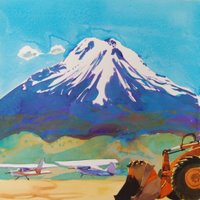 I have learned that my eyes need some "aclimatizing" before they can attempt to register the full range of color, hue and value in an outdoor scene. I have a hard time describing the process. My color perception appears to be highly correlated to the amount of time spent at a location, whether I'm wearing shades or spend time indoors. So I do not try to paint right after arrival. I wait at least a day or two if I can manage.
I have learned that my eyes need some "aclimatizing" before they can attempt to register the full range of color, hue and value in an outdoor scene. I have a hard time describing the process. My color perception appears to be highly correlated to the amount of time spent at a location, whether I'm wearing shades or spend time indoors. So I do not try to paint right after arrival. I wait at least a day or two if I can manage.But what if I'm just passing by? I was finally able to paint something more satisfactory after the fourth try. In this painting, I got rid of Payne's gray and used purple to define Shasta. The hills are suggested by two baseline transparencies (yellow ocre and a turquoise blue) overlapping at the horizon. But I had the most fun with the bobcat. I love mechanical objects. If you do watercolor, you will notice the sky's wash is quite imperfect. I have stopped trying to create perfect flat areas of color unless the painting calls for it. To me, it is what gives the medium its own vulnerability and appeal, otherwise, little will distinguish it from silkscreen or Flash.
No comments:
Post a Comment